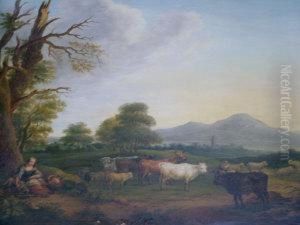Josef Adolf Lang Paintings
Josef Adolf Lang was a German painter known primarily for his landscape paintings. Born in 1781, Lang was part of the early 19th-century Romantic movement that emphasized emotion and individualism as well as glorification of all the past and nature.
Lang's early life and training are not well-documented, but it is known that he was active during a time when the Romantic movement was spreading across Europe. This period was characterized by a deep appreciation for the beauty of nature and a fascination with historical and folk themes. Lang's works often reflected these themes, capturing the sublime aspects of the natural world and the rural landscapes of Germany.
Throughout his career, Lang developed a distinctive style that made use of vivid colors and dynamic compositions to evoke the emotional power of the natural landscape. His paintings often featured dramatic skies, rugged terrain, and a sense of the awe-inspiring vastness of nature. He was also influenced by the works of other Romantic artists of the time, such as Caspar David Friedrich, who was known for his allegorical landscapes that evoked a sense of contemplation and solitude.
Despite his contributions to the Romantic movement and landscape painting, Josef Adolf Lang did not gain the same level of fame as some of his contemporaries. Nevertheless, his work was appreciated by those who valued the beauty and emotional depth of landscape art.
Lang lived through a period of significant social and political change in Germany, including the Napoleonic Wars and the eventual unification of the German states. These events may have also influenced his work to some extent, as Romantic artists often responded to the world around them through their art.
Josef Adolf Lang passed away in 1860, leaving behind a body of work that continues to be of interest to art historians and collectors who are passionate about the Romantic period and landscape painting. His paintings are a testament to the enduring appeal of nature as a subject for art and the capacity of the visual arts to evoke deep emotional responses.
